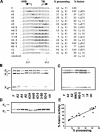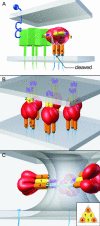Canine distemper virus and measles virus fusion glycoprotein trimers: partial membrane-proximal ectodomain cleavage enhances function
- PMID: 15254162
- PMCID: PMC446110
- DOI: 10.1128/JVI.78.15.7894-7903.2004
Canine distemper virus and measles virus fusion glycoprotein trimers: partial membrane-proximal ectodomain cleavage enhances function
Abstract
The trimeric fusion (F) glycoproteins of morbilliviruses are activated by furin cleavage of the precursor F(0) into the F(1) and F(2) subunits. Here we show that an additional membrane-proximal cleavage occurs and modulates F protein function. We initially observed that the ectodomain of approximately one in three measles virus (MV) F proteins is cleaved proximal to the membrane. Processing occurs after cleavage activation of the precursor F(0) into the F(1) and F(2) subunits, producing F(1a) and F(1b) fragments that are incorporated in viral particles. We also detected the F(1b) fragment, including the transmembrane domain and cytoplasmic tail, in cells expressing the canine distemper virus (CDV) or mumps virus F protein. Six membrane-proximal amino acids are necessary for efficient CDV F(1a/b) cleavage. These six amino acids can be exchanged with the corresponding MV F protein residues of different sequence without compromising function. Thus, structural elements of different sequence are functionally exchangeable. Finally, we showed that the alteration of a block of membrane-proximal amino acids results in diminished fusion activity in the context of a recombinant CDV. We envisage that selective loss of the membrane anchor in the external subunits of circularly arranged F protein trimers may disengage them from pulling the membrane centrifugally, thereby facilitating fusion pore formation.
Figures






Similar articles
-
Primary resistance mechanism of the canine distemper virus fusion protein against a small-molecule membrane fusion inhibitor.Virus Res. 2019 Jan 2;259:28-37. doi: 10.1016/j.virusres.2018.10.003. Epub 2018 Oct 5. Virus Res. 2019. PMID: 30296457
-
Inhibition of measles virus infection and fusion with peptides corresponding to the leucine zipper region of the fusion protein.J Gen Virol. 1997 Jan;78 ( Pt 1):107-11. doi: 10.1099/0022-1317-78-1-107. J Gen Virol. 1997. PMID: 9010292
-
Conserved leucine residue in the head region of morbillivirus fusion protein regulates the large conformational change during fusion activity.Biochemistry. 2009 Sep 29;48(38):9112-21. doi: 10.1021/bi9008566. Biochemistry. 2009. PMID: 19705836
-
Biological properties of phocine distemper virus and canine distemper virus.APMIS Suppl. 1993;36:1-51. APMIS Suppl. 1993. PMID: 8268007 Review.
-
Measles Virus Fusion Protein: Structure, Function and Inhibition.Viruses. 2016 Apr 21;8(4):112. doi: 10.3390/v8040112. Viruses. 2016. PMID: 27110811 Free PMC article. Review.
Cited by
-
Peste des petits ruminants virus infection of small ruminants: a comprehensive review.Viruses. 2014 Jun 6;6(6):2287-327. doi: 10.3390/v6062287. Viruses. 2014. PMID: 24915458 Free PMC article. Review.
-
MeV-Stealth: A CD46-specific oncolytic measles virus resistant to neutralization by measles-immune human serum.PLoS Pathog. 2021 Feb 3;17(2):e1009283. doi: 10.1371/journal.ppat.1009283. eCollection 2021 Feb. PLoS Pathog. 2021. PMID: 33534834 Free PMC article.
-
Canine morbillivirus (CDV): a review on current status, emergence and the diagnostics.Virusdisease. 2022 Sep;33(3):309-321. doi: 10.1007/s13337-022-00779-7. Epub 2022 Aug 25. Virusdisease. 2022. PMID: 36039286 Free PMC article. Review.
-
Receptor (SLAM [CD150]) recognition and the V protein sustain swift lymphocyte-based invasion of mucosal tissue and lymphatic organs by a morbillivirus.J Virol. 2006 Jun;80(12):6084-92. doi: 10.1128/JVI.00357-06. J Virol. 2006. PMID: 16731947 Free PMC article.
-
Canine distemper virus matrix protein influences particle infectivity, particle composition, and envelope distribution in polarized epithelial cells and modulates virulence.J Virol. 2011 Jul;85(14):7162-8. doi: 10.1128/JVI.00051-11. Epub 2011 May 4. J Virol. 2011. PMID: 21543493 Free PMC article.
References
-
- Baker, K. A., R. E. Dutch, R. A. Lamb, and T. S. Jardetzky. 1999. Structural basis for paramyxovirus-mediated membrane fusion. Mol. Cell 3:309-319. - PubMed
-
- Begona Ruiz-Arguello, M., L. Gonzalez-Reyes, L. J. Calder, C. Palomo, D. Martin, M. J. Saiz, B. Garcia-Barreno, J. J. Skehel, and J. A. Melero. 2002. Effect of proteolytic processing at two distinct sites on shape and aggregation of an anchorless fusion protein of human respiratory syncytial virus and fate of the intervening segment. Virology 298:317-326. - PubMed
Publication types
MeSH terms
Substances
Grants and funding
LinkOut - more resources
Full Text Sources
Other Literature Sources
Miscellaneous

